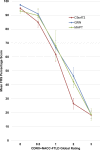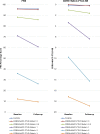Comparison of clinical rating scales in genetic frontotemporal dementia within the GENFI cohort
- PMID: 34353857
- PMCID: PMC8785074
- DOI: 10.1136/jnnp-2021-326868
Comparison of clinical rating scales in genetic frontotemporal dementia within the GENFI cohort
Abstract
Background: Therapeutic trials are now underway in genetic forms of frontotemporal dementia (FTD) but clinical outcome measures are limited. The two most commonly used measures, the Clinical Dementia Rating (CDR)+National Alzheimer's Disease Coordinating Center (NACC) Frontotemporal Lobar Degeneration (FTLD) and the FTD Rating Scale (FRS), have yet to be compared in detail in the genetic forms of FTD.
Methods: The CDR+NACC FTLD and FRS were assessed cross-sectionally in 725 consecutively recruited participants from the Genetic FTD Initiative: 457 mutation carriers (77 microtubule-associated protein tau (MAPT), 187 GRN, 193 C9orf72) and 268 family members without mutations (non-carrier control group). 231 mutation carriers (51 MAPT, 92 GRN, 88 C9orf72) and 145 non-carriers had available longitudinal data at a follow-up time point.
Results: Cross-sectionally, the mean FRS score was lower in all genetic groups compared with controls: GRN mutation carriers mean 83.4 (SD 27.0), MAPT mutation carriers 78.2 (28.8), C9orf72 mutation carriers 71.0 (34.0), controls 96.2 (7.7), p<0.001 for all comparisons, while the mean CDR+NACC FTLD Sum of Boxes was significantly higher in all genetic groups: GRN mutation carriers mean 2.6 (5.2), MAPT mutation carriers 3.2 (5.6), C9orf72 mutation carriers 4.2 (6.2), controls 0.2 (0.6), p<0.001 for all comparisons. Mean FRS score decreased and CDR+NACC FTLD Sum of Boxes increased with increasing disease severity within each individual genetic group. FRS and CDR+NACC FTLD Sum of Boxes scores were strongly negatively correlated across all mutation carriers (rs=-0.77, p<0.001) and within each genetic group (rs=-0.67 to -0.81, p<0.001 in each group). Nonetheless, discrepancies in disease staging were seen between the scales, and with each scale and clinician-judged symptomatic status. Longitudinally, annualised change in both FRS and CDR+NACC FTLD Sum of Boxes scores initially increased with disease severity level before decreasing in those with the most severe disease: controls -0.1 (6.0) for FRS, -0.1 (0.4) for CDR+NACC FTLD Sum of Boxes, asymptomatic mutation carriers -0.5 (8.2), 0.2 (0.9), prodromal disease -2.3 (9.9), 0.6 (2.7), mild disease -10.2 (18.6), 3.0 (4.1), moderate disease -9.6 (16.6), 4.4 (4.0), severe disease -2.7 (8.3), 1.7 (3.3). Sample sizes were calculated for a trial of prodromal mutation carriers: over 180 participants per arm would be needed to detect a moderate sized effect (30%) for both outcome measures, with sample sizes lower for the FRS.
Conclusions: Both the FRS and CDR+NACC FTLD measure disease severity in genetic FTD mutation carriers throughout the timeline of their disease, although the FRS may be preferable as an outcome measure. However, neither address a number of key symptoms in the FTD spectrum, for example, motor and neuropsychiatric deficits, which future scales will need to incorporate.
Keywords: frontotemporal dementia.
© Author(s) (or their employer(s)) 2022. Re-use permitted under CC BY. Published by BMJ.
Conflict of interest statement
Competing interests: None declared.
Figures





